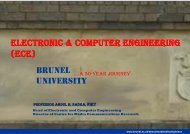DEliverable 2.3 - the School of Engineering and Design - Brunel ...
DEliverable 2.3 - the School of Engineering and Design - Brunel ...
DEliverable 2.3 - the School of Engineering and Design - Brunel ...
Create successful ePaper yourself
Turn your PDF publications into a flip-book with our unique Google optimized e-Paper software.
ICT Project 3D VIVANT– Deliverable <strong>2.3</strong><br />
Contract no.:<br />
248420<br />
User Acceptance Validation Plan<br />
• Service acceptance – As <strong>the</strong> hyperlinking <strong>of</strong> single moving objects in a videostream is a new<br />
video service scenario, <strong>the</strong> general acceptance <strong>of</strong> such a service by users has to be validated. The<br />
acceptance issues to be considered will include: did <strong>the</strong> end-users underst<strong>and</strong> <strong>the</strong> concept <strong>of</strong> <strong>the</strong><br />
service, did it fulfil <strong>the</strong>ir expectations, could <strong>the</strong>y imagine using it, would <strong>the</strong>y recommend it to<br />
<strong>the</strong>ir friends, what are <strong>the</strong> perceived benefits, what did <strong>the</strong>y like/dislike about it, etc.<br />
4.2.2 Search <strong>and</strong> Retrieval Framework<br />
Ano<strong>the</strong>r functionality that <strong>the</strong> 3D VIVANT system will support is <strong>the</strong> retrieval <strong>of</strong> objects similar to<br />
samples given by users. This functionality is expected to be used by pr<strong>of</strong>essional ra<strong>the</strong>r than by endusers.<br />
Pr<strong>of</strong>essional users will want to exploit this functionality, especially during 3D scene<br />
composition, when <strong>the</strong>y want to change <strong>the</strong> scene <strong>and</strong> replace certain objects with similar ones. It<br />
might be interesting for end-users to use this functionality to surf through or retrieve content from 3D<br />
holoscopic content databases. However, in <strong>the</strong> course <strong>of</strong> <strong>the</strong> project we can consider this technology<br />
as well as <strong>the</strong> availability <strong>of</strong> 3D holoscopic content as exclusive to pr<strong>of</strong>essional users.<br />
In 3D VIVANT, validation tests will be conducted only with pr<strong>of</strong>essional users to consider<br />
acceptance <strong>and</strong> usability issues with respect to functionality, performance <strong>and</strong> user friendliness<br />
aspects. More precisely <strong>the</strong>se are as follows:<br />
• Functionality – In this case, testing aims to validate user acceptance pertaining to whe<strong>the</strong>r <strong>the</strong><br />
architecture meets user expectations in terms <strong>of</strong> functionality. It associates with <strong>the</strong> completeness<br />
that <strong>the</strong> system <strong>of</strong>fers regarding <strong>the</strong> defined <strong>and</strong> implemented functions. It is focused on aspects,<br />
such as <strong>the</strong> supported content types (e.g., video, picture, 3D, 2D), search methods <strong>and</strong> metadata<br />
storage procedures, without emphasising on whe<strong>the</strong>r <strong>the</strong>se features are fast, reliable, friendly to<br />
<strong>the</strong> user, etc.<br />
• Performance – Validation testing will also consider <strong>the</strong> performance <strong>of</strong> <strong>the</strong> different functional<br />
modules in terms <strong>of</strong> retrieval accuracy, processing power requirements, storage capacity<br />
requirements <strong>and</strong> corresponding response latency. Retrieval accuracy is <strong>the</strong> core indicator <strong>of</strong> <strong>the</strong><br />
performance <strong>of</strong> any search engine as it can provide strong evidence about its actual usefulness<br />
<strong>and</strong> effectiveness. Retrieval accuracy reveals <strong>the</strong> capability <strong>of</strong> a search engine to discriminate<br />
between relevant <strong>and</strong> irrelevant objects with respect to <strong>the</strong> query <strong>and</strong> to present only <strong>the</strong> most<br />
relevant objects. However, it is important that a search engine not only is effective, but efficient<br />
as well. Resources are usually limited <strong>and</strong>, <strong>the</strong>refore, processing power <strong>and</strong> storage requirements<br />
are critical parameters so that a search <strong>and</strong> retrieval framework may be applied in practice <strong>and</strong><br />
exploited by end-users. Finally, a positive decision to accept a search <strong>and</strong> retrieval framework<br />
also depends on <strong>the</strong> time required to perform a retrieval request. In case that <strong>the</strong> user searches in<br />
small multimedia databases, time is not a critical parameter. However, as multimedia databases<br />
tend to grow exponentially, it becomes obvious that fast processing <strong>and</strong> system response get more<br />
<strong>and</strong> more significant.<br />
• User friendliness – Apart from <strong>the</strong> aforementioned characteristics, which refer mainly to <strong>the</strong><br />
technical aspects <strong>of</strong> <strong>the</strong> search <strong>and</strong> retrieval framework, validation tests will also investigate <strong>the</strong><br />
user friendliness <strong>and</strong> usability <strong>of</strong> <strong>the</strong> user interface allowing <strong>the</strong> searching <strong>of</strong> holoscopic content.<br />
These tests will be performed in <strong>the</strong> context <strong>of</strong> <strong>the</strong> general acceptance tests regarding <strong>the</strong> user<br />
interface <strong>of</strong> <strong>the</strong> 3D VIVANT system.<br />
01.09.11 21
















